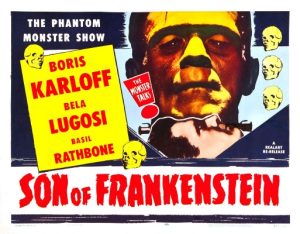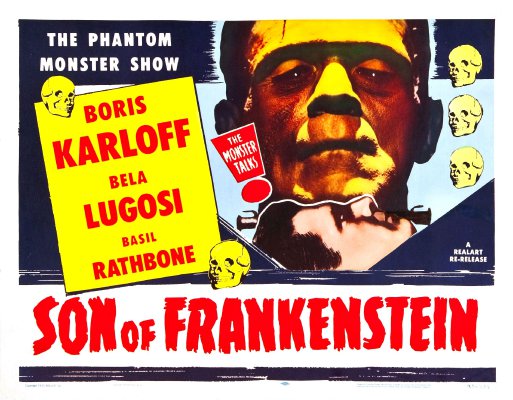
With the runaway success of the re-issue on a double bill of both “Dracula” and “Frankenstein” in the late nineteen thirties, Universal Studios decided it was time to resurrect their most lucrative property, the Frankenstein Monster, if the studio was to have any chance of surviving the fiscal year. True to form they originally intended to produce nothing more than a quick cheapie to cash in on the public’s renewed interest in horror films. Director Rowland V. Lee had other ideas. He envisioned the film as a modern fairy tale with Frankenstein’s Monster as the traditional giant ogre stalking a primordial landscape, and to be sure it is in this film that he first enters the realm of myth. To help achieve this goal he set Jack Otterson to create the most expressionistic sets of any horror film since “The Cabinet of Dr. Caligari”. The universe of “Son” is a world of perpetual night and fog; rain swept castles and blasted heaths; terrifying flashes of lightening; shadowy corridors where giants lurk; hidden passage ways leading to underground crypts, where time, dust and the worm aren’t the only things that move among the dead. “Son of Frankenstein” is the most visually impressive of all of Universal’s horror films and George Robinson’s gorgeous black and white cinematography captures every shadow, every out-sized distortion beautifully.
This would also be the last time a Frankenstein film would have a script worthy of the subject. Willis Cooper fashioned a contemporary Grimm’s fairy tale in which the journey of the film’s “outsiders”, Wolf, Elsa, and Peter will become progressively more nightmarish the deeper they descend; where even breakfast in the morning will be overseen by a pair of monstrous gargoyles. They’re journeying by train to inherit the Frankenstein estate, unknown to them a house literally at the edge of Hell, and these opening shots are the most “normal” in the entire film. They think of themselves as “explorers” and “exploring something so foreign we can’t even imagine what its like.” They speak of the castle being “haunted”, while outside the window we see through the wind and the rain a gray expanse of desolation and dead trees. “What a strange country!” Elsa exclaims. Their passage into the subterranean netherworld of mad doctors, murderous hunchbacks and monsters has begun and will climax in a necrophilic family reunion, (“We’re all dead here.”) in the Frankenstein crypt, in which both grandfather and father are dead, but the step-brother, the monster and family black sheep is very much alive. “Do you mean to imply that is my brother?” Wolf asks. Igor, the true Frankenstein family retainer replies, “Only his mother was the lightening.” And it is Wolf’s voyage from arrogance and ignorance, (“Why should we fear anything!”) to humility and wisdom, (“Never in my life have I known cold fear until that moment I felt his hand on my shoulder!”) which is central to the film.
While the film is a follow up to “Bride of Frankenstein”, it very much stands on its own. Gone are any references to the Bride and Dr, Praetorious, both presumably “blown to atoms” at the climax of that film. Also the monster doesn’t speak. All traces of speech, at Karloff’s insistence were eliminated. The portrait of Colin Clive as Henry Frankenstein dominates the castle’s study, and recalls the earlier films. In the scenes on the train Wolf refers to the, “Blunder of a stupid assistant who gave his father’s creation the brain of a killer instead of a normal one.” This is of course, a direct reference to the first film. Karloff’s return to his greatest role completes the linking of the three films. And consistent with the impressive visuals, the Monster is given his most striking look. Gone is the distinctly twentieth century black garb so beloved of the Universal Frankenstein films. Instead the Monster is clothed in a crude sheepskin jersey, with heavy shirt and trousers stitched together with strips of leather. Indeed, his whole appearance has become that of a giant, an ogre out of Grimm or Perrault. He even gets the traditional giant’s club in the form of Krogh’s wooden arm at the film’s climax. As if to underscore this, Peter gives the Monster a present-a storybook of fairy tales!
The film may have the greatest horror film cast ever. There is Karloff dominating as the Monster. Given less screen time than in the previous film, his scenes are still among his most powerful. To cite just two examples, the scene where he rises like Lucifer out of the pit is like an image from Dante’s Inferno while his primal howl of grief upon discovering the dead Igor is one of the Monster’s greatest moments from any of the Frankenstein films. Bela Lugosi easily has his best role after Dracula as the broken neck, hunchback, Igor. Creepy, roguish, even pitiable, one is reminded of what a fine actor he could be with a role worthy of his talent. Lionel Atwill with his beautifully clipped vocal delivery and sardonic sense of humor has his definitive screen role as the one arm Inspector Krogh; he doesn’t miss any opportunity for scene stealing bits of business with that wooden arm. And there is Basil Rathbone as Wolf. He doesn’t have Karloff’s make-up or Lugosi’s broken neck or Atwill’s wooden arm, but he gives a full-blooded commanding performance that refuses to get lost in this who’s who of cinematic ghouls. William K. Everson once said that only a truly great actor can get away with a little deliberate ham now and then, and if Rathbone is a little over the top, it is ham well seasoned and served and adds enormously to the enjoyment of the film. Finally Frank Skinner’s incredible film score would set the standard for Universal’s horror films for the next decade.

